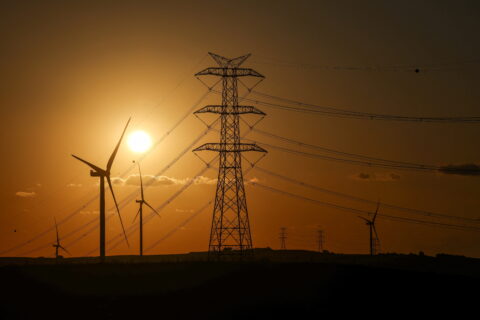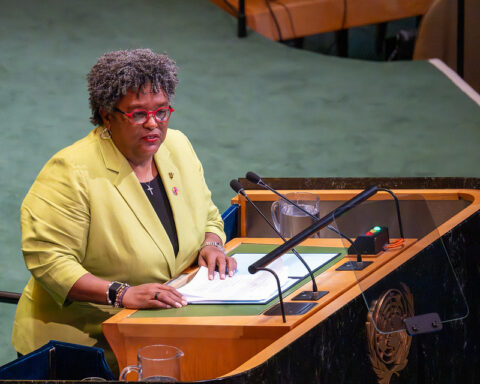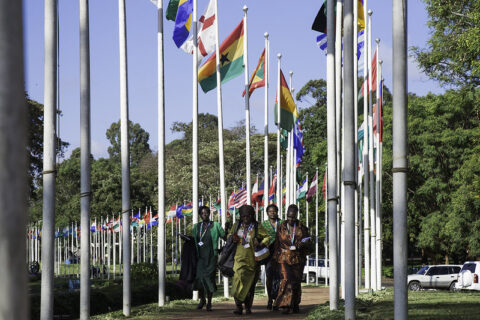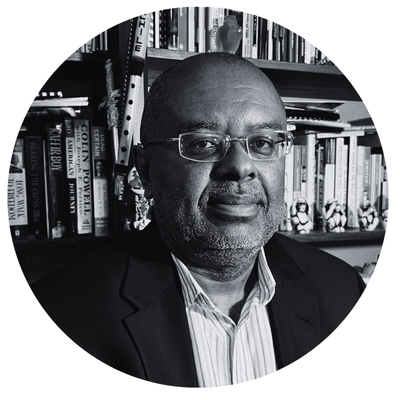Global electricity generation from solar will quadruple by 2030 and help to push coal power into reverse, according to Carbon Brief analysis of data from the International Energy Agency (IEA).
The IEA’s latest World Energy Outlook 2024 shows solar overtaking nuclear, wind, hydro, gas and, finally, coal, to become the world’s single-largest source of electricity by 2033.
This solar surge will help kickstart the “age of electricity”, the agency says, where rapidly expanding clean electricity and “inherently” greater efficiency will push fossil fuels into decline.
As a result, the world’s energy-related carbon dioxide (CO2) emissions will reach a peak “imminently”, the IEA says, with its data indicating a turning point in 2025.
Other highlights from Carbon Brief’s in-depth examination of the IEA’s latest outlook include:
- Renewables will grow 2.7-fold by 2030, short of the “tripling” goal set at COP28.
- Still, clean energy is growing at an “unprecedented rate”, and will overtake coal, gas and then oil, to become the world’s largest source of energy “in the mid-2030s”.
- Low-carbon energy, including renewables and nuclear, will grow 44% by 2030, adding 48 exajoules (EJ) to global energy supplies.
- Global energy demand will only rise by 34EJ (5%) over the same period.
- This means clean energy will push each of the fossil fuels past their peak by 2030.
- Electric vehicles (EVs) are now expected to displace 6m barrels of oil per day (mb/d) by 2030, up from a figure of 4mb/d by 2030 in last year’s outlook.
Despite these changes, the world is on track to cut CO2 emissions to just 4% below 2023 levels by 2030, the agency warns, resulting in warming of 2.4C above pre-industrial temperatures.
It says there is an “increasingly narrow, but still achievable” path to staying below 1.5C, which would need more clean electricity, faster electrification and a 33% cut in emissions by 2030.
This year, in light of heightened geopolitical risks and uncertainties, the IEA explores “sensitivities” around its core outlook. These include slower (or faster) uptake of electric vehicles (EVs), as well as faster growth in data-centre loads and more heatwave-driven demand for air conditioning.
The agency maintains that, even when these sensitivities are combined, global demand for coal, oil and gas – as well as CO2 emissions – would peak no more than a few years later than expected.
(See Carbon Brief’s coverage of previous IEA world energy outlooks from 2023, 2022, 2021, 2020, 2019, 2018, 2017, 2016 and 2015.)
World energy outlook
The IEA’s annual World Energy Outlook (WEO) is published every autumn. It is widely regarded as one of the most influential annual contributions to the understanding of climate and energy trends.
The outlook explores a range of scenarios, representing different possible futures for the global energy system. These are developed using the IEA’s “Global Energy and Climate Model”.
The 1.5C-compatible “net-zero emissions by 2050” (NZE) scenario was introduced in 2021 and updated in September 2023. The NZE is revised again in the WEO 2024 to reflect the fact that global CO2 emissions reached another record high last year, rather than falling.
The report says that the path to 1.5C is “increasingly narrow, but still achievable”. However, it adds:
“Every year in which global emissions rise and actions fall short of what is needed for the future makes this pathway steeper and harder to climb.”
Alongside the NZE is the “announced pledges scenario” (APS), in which governments are given the benefit of the doubt and assumed to meet all of their climate goals on time and in full.
Finally, the “stated policies scenario” (STEPS) represents “the prevailing direction of travel for the energy system, based on a detailed assessment of current policy settings”. Here, the IEA looks not at what governments are saying, but what they are actually doing.
Annex B of the report breaks down the policies and targets included in each scenario. In effect, the IEA is judging the seriousness of each target and whether it will be followed through.
For example, the provisions of the European Green Deal are included in the STEPS. But the EU target to cut emissions to 55% below 1990 levels by 2030 is only met under the APS.
Since last year’s report, some 38 countries responsible for a third of global energy-related CO2 emissions have introduced new clean-energy measures, the IEA says.
It mentions South Korea’s 11th electricity plan, which “includes a significant expansion of nuclear, wind and solar”, and the new UK government “lift[ing] the de-facto ban on new onshore wind”.
(It says there have also been “some rollbacks” of climate policy over the past year, such as Javier Milei’s reforms in Argentina, but the global impact of these is “relatively small”.)

The report emphasises that “none of the scenarios should be viewed as a forecast”. It adds:
“Our scenario analysis is designed to inform decisionmakers as they consider options, not to predict how they will act.”
Earlier this year, some US politicians and analysts criticised the IEA’s work, in particular, its suggestion in WEO 2023 that demand for oil, coal and gas would each peak before 2030. They also argued that the IEA was straying from its core focus on energy security.
At the time, the agency defended its approach in a response to Senate Republicans.
This year’s edition goes on to reiterate the IEA’s view that fossil fuels will peak this decade – and pushes back on the idea that climate change and clean energy are outside its mission.
It says that “more efficient, cleaner energy systems can reduce energy security risks” and that a “comprehensive approach to energy security…needs to extend beyond traditional fuels”.
In his foreword to the report, IEA executive director Fatih Birol adds:
“The concept of energy security goes well beyond safeguarding against traditional risks to oil and natural gas supplies, as important as that remains for the global economy.”
He says that, in addition to those issues, energy security includes access to affordable energy supplies, secure supply chains for clean-energy technologies and dealing with the rising threat of extreme weather disruption to energy systems. Birol’s foreword continues:
“The analysis in this year’s outlook reinforces my long-held conviction that energy security and climate action go hand-in-hand…This is because deploying cost-competitive clean energy technologies represents a lasting solution not only for bringing down emissions, but also for reducing reliance on fuels that have been prone to volatility and disruption.”
Discussing the controversy over fossil-fuel peaking in a press briefing to launch this year’s report, Birol said that the latest data – and the outlooks of several major international oil and gas companies – had “confirmed and reconfirmed” the IEA’s position on oil demand.
Birol said press reports had described the latest data as “vindication” for the IEA’s forecast of minimal growth in oil demand this year. But he added: “It’s not a vindication of the IEA, it’s a vindication of numbers and objective analysis.”
Nevertheless, this year’s outlook puts extra emphasis on the uncertainty surrounding its scenarios. It devotes an entire chapter to exploring “sensitivities”, such as slower growth in EV sales or a more rapid escalation of heatwaves driving demand for air conditioning.
Even when these sensitivities are combined in ways that would slow climate action, however, the IEA says that oil demand still peaks and begins to decline by 2035. Similarly, global CO2 emissions would be less than 2% higher in 2030 and 1% in 2035 than in the core outlook.
‘Age of electricity’
A central theme of this year’s outlook is the idea that the global energy system is entering a new era, defined by rapid growth in electricity demand and a surge in clean electricity supplies.
In a press release accompanying the report, Birol calls this new era the “age of electricity”, in contrast to the earlier “age of coal” and “age of oil”. (The “golden age of gas”, predicted by the IEA in 2012, was prematurely brought to an end by the global energy crisis, driven by high gas prices.)
Birol says “the future of the energy system is electric” and that it is “moving at speed” towards “increasingly be[ing] based on clean sources of electricity”. In the report foreword he adds:
“The latest outlook also confirms that the contours of a new, more electrified energy system are becoming increasingly evident, with major implications on how we meet rising demand for energy services. Clean electricity is the future, and one of the striking findings of this outlook is how fast demand for electricity is set to rise, with the equivalent of the electricity use of the world’s ten largest cities being added to global demand each year.”
The IEA says that electricity demand is set to rise six times faster than global energy demand overall, in the years out to 2035, having only been twice as fast since 2010.

Moreover, despite a rapid acceleration in recent years, clean electricity has not yet grown fast enough to meet rising demand, leaving space for fossil-fueled power to continue expanding.
Global solar capacity is now 40-times larger than it was in 2010 and wind six times larger, the outlook notes, and a record 560 gigawatts (GW) of renewables were added in 2023.
Yet growth in clean electricity supplies has still fallen short of rising demand, meaning coal power has climbed 23% since 2010 and gas by 36%, raising emissions in the sector by 20%.
This is now set to change. The report says:
“It is now cheaper to build onshore wind and solar power projects than new fossil-fuel plants almost everywhere around the world, and the economic arguments remain strong even when considering the accompanying investment required to cope with their variability of generation.”
Renewables are only on track to expand 2.7-fold from 2022 to 2030 – short of the tripling target set at COP28 – but clean electricity will still outstrip rising demand, out to 2030 and beyond.
The IEA data shows that the amount of electricity generated from solar power alone is set to quadruple from 2023 levels by 2030 – and to climb more than nine-fold by 2050.
This means that solar will overtake nuclear, hydro and wind in 2026, gas in 2031 – and then coal by 2033 – to become the world’s largest source of electricity, as shown in the figure below.
Along with a doubling of wind generation and more modest gains for nuclear and hydro by 2030, clean electricity will push coal power into reverse, declining 13% by 2030 and 34% by 2035.
(The outlook sees modest growth of 6% by 2030 for gas power, but most of this would be erased by 2035 as clean electricity supplies continue to expand.)
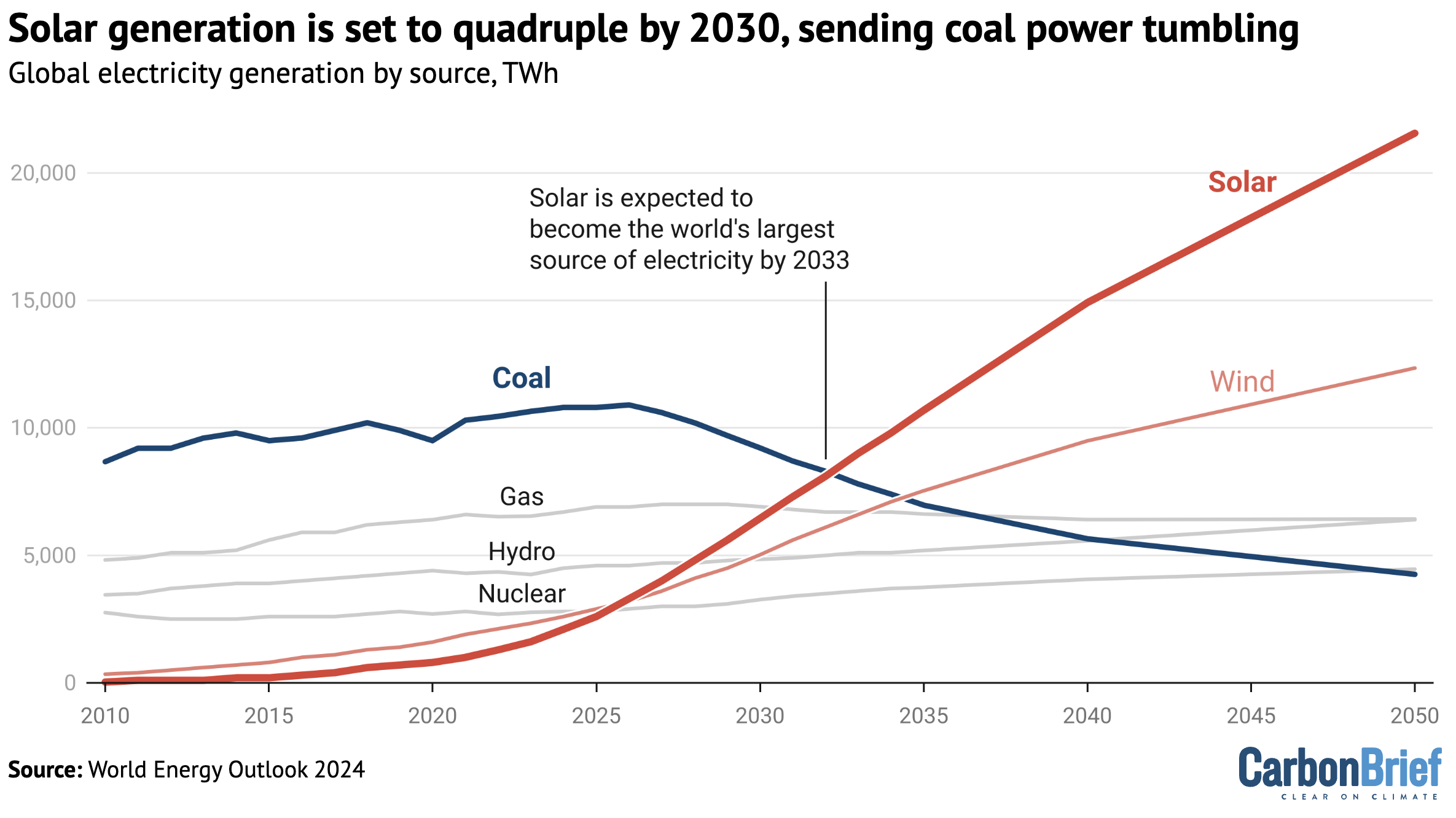
The IEA says that China was responsible for 60% of worldwide renewable installations last year – and will add 60% of new capacity out to 2030. This means that by the early 2030s, solar generation in China alone is set to exceed the US’ current total electricity demand.
Notably, this year’s report includes another significant boost to the outlook for solar under current policy settings.
The IEA now sees global solar capacity exceeding 16,000GW by 2050, some 30% higher than expected last year and nearly 11-times higher than it thought in 2015, as shown in the figure below.
By 2023, the world had already installed 1,610GW of solar capacity. This comfortably exceeded the 1,405GW of capacity that the IEA had expected in 2050, under prevailing policy settings in its 2015 world energy outlook, released before the Paris Agreement later that year.

Similarly, this year’s outlook says battery storage capacity will reach 1,630GW by 2030. Only two years ago, it had said battery capacity would reach just 1,296GW by 2050.
In addition to raising the outlook for solar and storage, however, this year’s report also includes significantly higher global electricity demand, which has been revised upwards by 5% in 2030.
This 1,700 terawatt-hour (TWh) revision to global demand in 2030 – nearly equivalent to current electricity use in India – is much larger than the 1,000TWh adjustment for solar.
As a result, the IEA has also raised its outlook for coal power in 2030 by nearly 900TWh.
The IEA says that higher electricity demand is “mainly” down to “increased light industry activity, notably in China, much of it associated with a rapid rise in clean-technology manufacturing”.
Other factors include faster-than-expected adoption of EVs, more rapid electrification in industry in developing countries and the rise of data centres.
(The IEA, nevertheless, pours cold water on over-hyped reporting of AI-driven growth in data-centre electricity demand, which it sees accounting for barely 3% of growth to 2030, overall.)
Alongside growth in wind and solar, the report stresses the need for “a wide set of dispatchable low-emissions sources, including hydropower, bioenergy and nuclear power”.
It also emphasises the need for rising investment in electricity grids and storage. Spending in these areas is currently only two-thirds of investment in renewables, whereas parity will be needed to facilitate clean electricity expansion and ensure resilience to extreme weather and cyberattacks.
Fossil fuels peak by 2030
The “age of electricity” will have important implications for the current fossil-fuelled energy system, the report says. These include a reduction in the rate of global energy demand growth, even as demand for “energy services” – such as heat and mobility – rises rapidly in the developing world.
Explaining this apparent paradox, the IEA says that much of the energy released by burning fossil fuels is lost as waste heat. In contrast, a “more electrified, renewables-rich system is inherently more efficient”. This means less energy will be required to deliver the same energy services.
For example, electric technologies such as EVs and heat pumps deliver mobility and heat much more efficiently than internal combustion engines or fossil fuel boilers, the report says.
As the “age of electricity” gains pace, sources of energy demand across all sectors of the economy will be increasingly electrified, including heating, cooling, mobility and industrial processes.
This means the share of final energy consumption met by electricity will rise from 17% in 2010 and 20% in 2023 to 24% by 2030 and 32% by 2050, the outlook says – a more than 50% rise on current levels of electrification.
(Earlier this year, the Rocky Mountain Institute said China had “leapfrogged” other major countries in terms of rapid electrification, becoming what it termed the “first major electrostate”. Electricity already accounts for 26% of its energy consumption and will reach nearly 45% by 2050.)
Notably, the IEA has also been edging up its outlook for electrification, reflecting repeated boosts to its view on the deployment of electric technologies such as EVs and heat pumps. In 2015, it only expected electricity to meet 26% of final demand in 2050.
The rise of electrification, fed by expanding clean electricity sources, is now on the cusp of sending fossil fuels into decline, the outlook shows. As noted above, this year’s report reiterates the agency’s view that coal, oil and gas will each reach a peak this decade. It says:
“In the STEPS, coal demand begins to decline around 2025, while oil and natural gas demand both peak towards the end of the decade.”
Indeed, the outlook data shows global energy supply growing 34EJ (5%) by 2030, with this growth easily outpaced by clean-energy expansion of 48EJ (44%). As a result, fossil fuels in aggregate will be pushed into decline, as shown in the figure below.

The chart above shows how shifts in the global policy and technology landscape since the 2015 Paris Agreement have transformed the outlook for fossil-fuel growth.
Instead of the continuation of historical growth rates expected before Paris, the IEA has in recent years shifted its outlook, to a peak and increasingly steep decline in fossil-fuel demand.
Indeed, this year’s report points to fossil-fuel demand under current policy settings declining at a rate that is nearly in line with the climate pledges countries had made in 2021.
For example, the report says that China’s rapid uptake of EVs is spurring a “major slowdown” in oil demand growth globally, which is “wrong-footing oil producers”. It explains:
“China has been the engine of oil-market growth in recent decades, but that engine is now switching over to electricity.”
Indeed, the rise of electric mobility around the world is set to displace 6mb/d of oil demand by 2030, the outlook says, up from the 4mb/d it expected last year.
It notes that despite negative reporting, global EV sales were up 25% in the first half of 2024, with China accounting for 80% of the increase, but the rest of the world’s market also up 10%.
Nevertheless, the chart above illustrates the large gap between the current trajectory of the global energy system and what would be needed to meet existing national climate pledges, let alone the Paris Agreement target of limiting warming to “well-below” 2C or 1.5C.
Insufficient progress on emissions
This year’s outlook puts the gap between climate ambition and the world’s current trajectory into stark relief, saying that prevailing policy settings would likely see warming reach 2.4C this century.
Reflecting the marginally higher outlook for coal use in the short term, but more rapid fossil fuel declines in the medium and longer terms, this 2.4C assessment is the same as last year’s report.
This combination of changes is illustrated in the figure below, showing how the outlook for global energy-related CO2 emissions (grey line) has changed since 2015 (dashes). The IEA now says CO2 emissions will peak “imminently”, with its data pointing towards a peak in 2025.
(Last year, the outlook said emissions would peak by 2025 at the latest.)

The chart above illustrates how new policies and technological progress since the Paris Agreement are bending the curve of global CO2 emissions away from the 3.5C of warming expected in 2015.
Still, it also shows the massive gap that would need to be bridged in order to meet national climate pledges for 2030 and for reaching net-zero emissions by mid-century (blue line). And it shows the huge scale of the gap to the “increasingly narrow, but still achievable” path to 1.5C.
While current policy settings would cut global CO2 emissions to 4% below 2023 levels by 2030, according to the IEA, a far larger 33% reduction would be needed for 1.5C.
A separate report from the IEA, published last month, shows how countries could close most of this gap “by fully implementing the 2030 goals they agreed at COP28”.
These goals included doubling the rate of energy efficiency improvements and tripling global renewable capacity by 2030. Together, these two elements “could provide larger emissions reductions by 2030 than anything else”, the outlook says.
It reinforces the key changes that would be needed to get on track for current climate pledges – which would limit warming in 2100 to around 1.7C – or to limit warming to 1.5C.
In broad terms, this would mean even faster electrification and deployment of clean-energy technologies, as well as taking rapid action to cut methane emissions from the oil and gas industry.
(Instead of electricity’s share of final energy use increasing from 20% to 32% by 2050, as under current policy settings, electrification rates would double to 42% by 2050, if climate pledges are met, and would nearly triple to 55%, if the world gets on track for 1.5C.)
More specifically, the IEA points to “seven key clean-energy technologies”: solar; wind; nuclear; EVs; heat pumps; low-emissions hydrogen; and carbon capture and storage.
The report says the world has “the need and the capacity to go much faster” in these areas, which – unlike the current trajectory – would bring global emissions into a “meaningful decline”.
Spotlighting the need for a positive outcome in upcoming climate-finance discussions at the COP29 UN summit in November in Baku, Azerbaijan, the IEA says that high financing costs and project risks are limiting the spread of these clean-energy technologies in developing countries.
Concluding his report foreword, the IEA’s Birol emphasises the choices facing governments, investors and consumers. He writes:
“This WEO highlights, once again, the choices that can move the energy system in a safer and more sustainable direction. I urge decision makers around the world to use this analysis to understand how the energy landscape is changing, and how to accelerate this clean energy transformation in ways that benefit people’s lives and future prosperity.”
The outlook warns that decisionmakers “too often entrench the flaws in today’s energy system, rather than pushing it towards a cleaner and safer path”. It adds: “[L]ocking in fossil fuel use has consequences…the costs of climate inaction…grow higher by the day.”
The post Analysis: Solar surge will send coal power tumbling by 2030, IEA data reveals appeared first on Carbon Brief.
Analysis: Solar surge will send coal power tumbling by 2030, IEA data reveals
Climate Change
Panama environment minister backs calls for reform of UN climate process
Panama’s environment minister has joined a growing push for reform of the UN climate change negotiations, proposed by campaigners and academics in recent years – one of the first such calls by a minister directly involved in the talks.
Juan Carlos Navarro told Climate Home in a recent interview on the sidelines of Climate Week in New York that the current system for approving decisions – which requires all countries to agree by consensus – has not delivered good enough results and should instead use a majority or super-majority decision-making process.
“By consensus, you cannot get 186 nations to agree on anything. It’s a miracle we have come so far,” said Navarro. “We need to change the rules so we have a basic, rational, majority or super-majority decision-making process where we can do things better and faster.”
The comments follow pressure from civil society and academics to reform the UN climate process. In June, more than 200 campaign groups issued a joint call to reform the decision-making process, which they argued can be blocked by oil and gas-producing countries and has reached a “breaking point”.
Andreas Sieber, policy director with climate advocacy group 350.org, said he was sympathetic to Panama’s proposal, but added “it would just be part of a puzzle” to make the UN climate talks work more efficiently.
He added that it could be hard to get over the line as earlier efforts to secure a rule on voting as a last resort had met with fierce opposition from oil-producing countries – and decisions reached by consensus have the weight of having all the countries behind them, he noted.
Erika Lennon, Senior Attorney at the Center for International Environmental Law, celebrated that more people are talking about potential changes to the UNFCCC, as “being totally beholden to consensus-based decision making is not leading to the outcomes that we need”.
She also agreed that voting is just part of the solution, and suggested possible reforms could include increased transparency in the negotiation rooms, inclusion of civil society and indigenous groups, and a conflict of interest rule that blocks fossil fuel companies from participating.
During last year’s COP29 in Baku, a group of experts known as the Club of Rome – among them the former UN climate chief Christiana Figueres and former UN Secretary-General Ban Ki Moon – issued an open letter proposing ways to modernise the climate process.
The current structure of COPs “simply cannot deliver the change at exponential speed and scale, which is essential to ensure a safe climate landing for humanity”, the letter said. They argued instead for “smaller, more frequent, solution-driven meetings” where countries can discuss progress and be held accountable.
At that same COP in Azerbaijan, Saudi Arabia managed to block all mentions of fossil fuels in text summarising discussions on cutting greenhouse gas emissions. It was able to do this despite all countries having agreed to transition away from fossil fuels in energy systems just one year earlier at COP28.
UN Climate Change consults on COP process
In a speech at Climate Week in New York, Simon Stiell, the executive secretary of UN Climate Change, noted that recent COPs have delivered “concrete results and global steps forward”, adding that cooperation under the process has lowered expected global warming from 5C to closer to 3C.
But, he conceded, it is “imperfect”. “As this new era of implementation gathers pace, we must also keep evolving, and striving towards faster, fully-inclusive, higher-quality decisions that tie the formal process ever-closer to real economies and real lives,” he said.
Senior experts have been asked to examine how the UN climate process could be improved and will deliver their ideas to Stiell later this year. The secretariat will consult with countries on any potential reforms it wants to pursue in 2026, the UN’s climate chief added.
Brazil, the host country of this year’s COP, has put the focus on global mobilisation to implement in practice what governments signed up to in the 2015 Paris Agreement. Last year it proposed setting up a UN Climate Change Council in order to support that work, but this proposal does not seem to have gained much traction amid geopolitical tensions and Trump’s attacks on multilateral climate action.

Downsizing COPs?
Panama’s Navarro added that the UN climate summit has grown too big, making its scope “ridiculous”. In 2023, over 83,000 people attended COP28 in Dubai, while COP29 in Baku saw fewer, with 66,778 registered participants.
Navarro said the COP meetings had become an anachronism. “You have thousands and thousands of people who are living off the story,” he said. “They’re living off these meetings, just sitting around the world on expense accounts, creating a bigger carbon footprint for the planet, and we’re not achieving anything.”
In April 2024, UNFCCC head Stiell said personally he “would certainly like to see future COPs reduce in size”, telling an audience at London’s Chatham House think-tank that “bigger doesn’t necessarily mean better”.
This year, COP30 will be held in the Amazon city of Belem, which poses “self-evident” financial and logistical limitations, according to Navarro, who praised Brazil for being open to hearing the complaints from the Global South countries on this topic.
After many delegations complained over the high costs of accommodation and difficult access, Brazil offered cruise-ship rooms and price caps, and the UN has increased the daily subsidy for diplomats from most developing nations to attend the summit.
Landmark ICJ climate ruling must be turned into concrete action on shipping
‘Less hypocrisy, more concrete results’
“Having said that, and coming back to the point of what COPs have become, I wish that COPs were less bullshit, more concrete results,” Navarro told Climate Home.
His own country – which is judged to be carbon-negative, thanks to its extensive carbon-storing forests – recently published its “Nature Pledge”, combining climate, biodiversity and conservation pledges. Those include restoring 100,000 hectares of ecosystems such as degraded mangroves by 2035, maintaining 30% of Panama’s land and seas under protection and absorbing 5 million tons of CO₂.
Practical measures to achieve that include new equipment for park rangers, more radars to monitor and catch illegal fishing, and fines for polluting industries.
Panama has also set up a Nature Fund, which aims to collect $150 million-$200 million for conservation projects using resources like blue carbon bonds, debt-for-nature swaps and a national carbon market backed by blockchain with revenues going to the public sector to ensure “transparency and accountability”.
Without specifying which, Navarro called out “countries that do an incredible job of greenwashing, talking about conservation and talking about the environment – and they’re either oil producers or plastics producers, or kill whales or are destroying our fisheries, or keep building coal power plants or keep polluting”.
“We’ve run out of time for all of these hypocritical individuals, corporations – or even nations,” he added.
The post Panama environment minister backs calls for reform of UN climate process appeared first on Climate Home News.
Panama environment minister backs calls for reform of UN climate process
Climate Change
AI and satellite data help researchers map world’s transition minerals rush
Researchers are using satellite images and AI-powered modelling to map global mining activity, seeking to plug gaps in existing data as the rush for “transition minerals” fuels concerns about the industry’s impact on the environment and local communities.
Countries are scrambling to shore up supplies of metals vital for the transition to renewables, such as lithium used in electric vehicle (EV) batteries, and copper – used in solar panels and wind turbines, many of which are produced in environmentally sensitive areas.
“New mines will likely be in areas of high biodiversity, or where water and Indigenous rights are at stake,” project lead Victor Maus from the Vienna University of Economics and Business told Climate Home News.
More than half of energy transition mineral resources are located on or near the lands of Indigenous peoples and subsistence farmers, according to a 2022 study published in the Nature journal.
“Monitoring those impacts is critical,” said Maus, whose team members have identified massive gaps in current data when it comes to what, how and even where minerals are being extracted around the world.
During a previous project, they compared global satellite imagery of 120,000 square kilometres of visible mine footprints with the S&P Capital IQ Pro database of mining production. The results were stark. More than half of the mining areas identified from space had no corresponding production data in the official record.
To address these gaps, Maus and his team are building a mining database using satellite images. The project, which is part of the European Union-funded Mine the Gap initiative, will be a vital tool for policymakers and help foster transparency in the mining industry, he added.
“We’re hoping to create not only a research tool but also a means of validating and complementing what companies report, supporting greater transparency across the sector.”
Mapping environmental impact
As well as counting mines and assessing overall production, the database will give a clearer picture about where the biggest environmental and social risks lie by tracking land use around mines, waste generation and signs of environmental degradation.
“Simply knowing how much is being produced isn’t a direct measurement of impact,” said Tim Werner, a senior lecturer at The University of Melbourne who has worked with Maus on previous research into critical minerals.
“We simply don’t have all the information we need to scientifically prove where impacts for one area are worse than others. This is a big problem for strategic environmental management at national and global scales,” he added, describing the data gaps as “mind-boggling”.
A range of satellites are being used to collect the required information, including multispectral imagery, radar and hyperspectral sensors, collected from sources including the EU’s Sentinel constellation and German DLR satellites, chosen for their global coverage and accuracy.
AI will then be used to scan these images, learning how to identify and track potential issues as the project develops.
The challenges of collecting mining data
There have been previous attempts to map the overlap between energy transition mineral mines and key biodiversity hotspots in different mineral-rich countries, as well as industry efforts to plug the gaps in data about global mining production.
But past efforts to map global mining more accurately have struggled to document small-scale and artisanal mining operations, which are often unregulated despite their significant social and environmental impacts.
In September, the International Council on Mining and Metals (ICMM) launched its global mining database – reportedly the most comprehensive mining resource to date, with information about more than 15,000 active facilities in 151 countries, but it does not include informal mining sites.
“We had to draw some scope boundaries,” said Emma Gagen, the ICMM’s data and research director. “The industry is huge and that’s been the challenge this whole time – people haven’t tried to collect this data before because it’s so vast.”
The case for clearer global standards
Despite such data initiatives, which reflect growing pressure on the industry to clean up its act, researchers say structural and legislative changes will be needed to reduce the harms caused by mining.
Gagen said more uniform regulatory standards would “drive performance improvements across the industry.”
“What’s most needed is alignment,” Maus said. “Clearer global standards on what should be measured and reported, and policies that encourage disclosure of mining data.”
For Maus and his team, having an accurate picture is a crucial first step.
“If we don’t even know how many materials are being produced, we’ve got very little basis to even understand the scale of possible impacts in an area,” Werner said.
Main image: Satellite image showing the expansion of nickel mining in Sulawesi, Indonesia (Photo: Sentinel-2 cloudless by EOX IT Services GmbH, which contains modified Copernicus Sentinel data 2024)
The post AI and satellite data help researchers map world’s transition minerals rush appeared first on Climate Home News.
AI and satellite data help researchers map world’s transition minerals rush
Climate Change
Experts: The key ‘unknowns’ of overshooting the 1.5C global-warming limit
Last week, around 180 scientists, researchers and legal experts gathered in Laxenburg, Austria to attend the first-ever international conference focused on the controversial topic of climate “overshoot”.
This hypothesised scenario would see global temperatures initially “overshoot” the Paris Agreement’s aspirational limit of 1.5C, before they are brought back down through techniques that would remove carbon dioxide from the atmosphere.
(For more on the key talking points, new research and discussions that emerged from the three-day conference, see Carbon Brief’s full write-up of the event.)
On the sidelines of the conference, Carbon Brief asked a range of delegates what they consider to be the key “unknowns” around overshoot.
Below are their responses, first as sample quotes, then, in full:
- Dr James Fletcher: “Yes, there will be overshoot, but at what point will that overshoot peak? Are we peaking at 1.6C, 1.7C, 2.1C?”
- Prof Shobha Maharaj: “There are lots of places in the world where adaptation plans have been made to a 1.5C ceiling. The fact is that these plans are going to need to be modified or probably redeveloped.”
- Sir Prof Jim Skea: “There are huge knowledge gaps around overshoot and carbon dioxide removal.”
- Prof Kristie Ebi: “If there is going to be a peak – and, of course, we don’t know what that peak is – then how do you start planning?”
- Prof Lavanya Rajamani: “To me, a key governance unknown is the extent to which our current legal and regulatory architecture…will actually be responsive to the needs of an overshoot world.”
- Prof Nebojsa Nakicenovic: “One of my major concerns has been for a long time…is whether, even after reaching net-zero, negative emissions can actually produce a temperature decline.”
- Prof Debra Roberts: “For me, the big unknown is how all of these areas of increased impact and risk actually intersect with one another and what that means in the real world.”
- Prof Oliver Geden: “[A key unknown] is whether countries are really willing to commit to net-negative trajectories.”
- Dr Carl-Friedrich Schleussner: “This is a bigger concern that I have – that we are pushing the habitability in our societies on this planet above that limit and towards maybe existential limits.”
- Dr Anna Pirani: “I think that tracking global mean surface temperature on an overshoot pathway will be an important unknown.”
- Prof Richard Betts: “One of the key unknowns is are we going to continue to get the land carbon sink that the models produce.”
- Prof Hannah Daly: “The biggest unknown is whether countries can translate these global [overshoot] pathways into sustained domestic action…that is politically and socially feasible.”
- Dr Andrew King: “[W]e still have a lot of uncertainty around other elements in the climate system that relate more to what people actually live through.”
Former minister for public service, sustainable development, energy, science and technology for Saint Lucia and negotiator at COP21 in Paris.
The key unknown is where we’re going to land. At what point will we peak [temperatures] before we start going down, and how long will we stay in that overshoot period? That is a scary thing. Yes, there will be overshoot, but at what point will that overshoot peak? Are we peaking at 1.6C, 1.7C, 2.1C? All of these are scary scenarios for small island developing states – anything above 1.5C is scary. Every fraction of a degree matters to us. Where we peak is very important and how long we stay in this overshoot period is equally important. That’s when you start getting into very serious, irreversible impacts and tipping points.
Adjunct professor at the University of Fiji and a coordinating lead author for Working Group II of the IPCC’s seventh assessment
First of all, there is an assumption that we’re going to go back down from overshoot. Back down is not a given. And secondly, we are still in the phase where we are talking about uncertainty. Climate scientists don’t like uncertainty. We are not acknowledging that uncertainty is the new normal… But because we’re so bogged down in terms of uncertainties, we are not moving towards [the issue of] what we do about it. We know it’s coming. We know the temperatures are going to be high. But there is little talk about the action.
The focus seems to be more on how we can understand this or how we can model this, but not what we do on the ground. Especially when it comes to adaptation planning – [and around] how does this modify whatever the plans are? There are lots of places in the world where adaptation plans have been made to a 1.5C ceiling. The fact is that these plans are going to need to be modified or probably redeveloped. And no one is talking about this, especially in the areas that are least resourced in the world – which sets up a big, big problem.
Chair of the Intergovernmental Panel on Climate Change (IPCC) and emeritus professor at Imperial College London’s Centre for Environmental Policy
There are huge knowledge gaps around overshoot and carbon dioxide removal. As it’s very clear from the themes of this conference, we don’t altogether understand how the Earth would react in taking carbon dioxide out of the atmosphere. We don’t understand the nature of the irreversibilities and we don’t understand the effectiveness of CDR techniques, which might themselves be influenced by the level of global warming, plus all the equity and sustainability issues surrounding using CDR techniques.
Professor of global health at the University of Washington‘s Center for Health and the Global Environment
There are all kinds of questions about adaptation and how to approach effective adaptation. At the moment, adaptation is primarily assuming a continual increase in global mean surface temperature. If there is going to be a peak – and of course, we don’t know what that peak is – then how do you start planning? Do you change your planning? There are places, for instance when thinking about hard infrastructure, [where overshoot] may result in a change in your plan – because as you come down the backside, maybe the need would be less. For example, when building a bridge taller. And when implementing early warning systems, how do you take into account that there will be a peak and ultimately a decline? There is almost no work in that. I would say that’s one of the critical unknowns.
Professor of international environmental law at the University of Oxford
I think there are several scientific unknowns, but I would like to focus on the governance unknowns with respect to overshoot. To me, a key governance unknown is the extent to which our current legal and regulatory architecture – across levels of governance, so domestic, regional and international – will actually be responsive to the needs of an overshoot world and the consequences of actually not having regulatory and governance architectures in place to address overshoot.
Distinguished emeritus research scholar at the International Institute for Applied Systems Analysis and executive director of The World In 2050.
One of my major concerns has been for a long time – as it was clear that we are heading for an overshoot, as we are not reducing the emissions in time – is whether, even after reaching net-zero, negative emissions can actually produce a temperature decline…In other words, there might be asymmetry on the way down [in the global-temperature response to carbon removal] – it might not be symmetrical to the way up [as temperature rise in response to carbon emissions]. And this is really my major concern, that we are planning measures that are so uncertain that we don’t know whether they will reach the goal.
The last point I want to make is that I think that the scientific community should, under all conditions, make sure that the highest priority is on mitigation.
Honorary professor at the University of KwaZulu-Natal, coordinating lead author on the IPCC’s forthcoming special report on climate change and cities, board chair of the Red Cross Red Crescent Climate Centre and co-chair of Working Group II for the IPCC’s sixth assessment
Well, I think coming from the policy and practitioner community, what I’m hearing a lot about are the potential impacts that come from the exceedance component of overshoot. What I’m not hearing a lot about is the responses to overshoot and their impacts – and how those impacts might interact with the impacts from temperature exceedance. So there’s quite a complex risk landscape emerging. It’s three dimensional in many ways, but we’re only talking about one dimension and, for policymakers, we need to understand that three dimensional element in order to understand what options remain on the table. For me, the big unknown is how all of these areas of increased impact and risk actually intersect with one another and what that means in the real world.
Senior fellow and head of the climate policy and politics research cluster at the German Institute for International and Security Affairs and vice-chair of IPCC Working Group III
[A key unknown] is whether countries are really willing to commit to net-negative trajectories. We are assuming, in science, global pathways going net negative, with hardly any country saying they want to go there. So maybe it is just an academic thought experiment. So we don’t know yet if [overshoot] is even relevant. It is relevant in the sense that if we do, [the] 1.5C [target] stays on the table. But I think the next phase needs to be that countries – or the UNFCCC as a whole – needs to decide what they want to do.
Research group leader and senior research scholar at the International Institute for Applied Systems Analysis
I’m convinced that there’s an upper limit of overshoot that we can afford – and it might be not far outside the Paris range [1.5C-2C] – before human societies will be overwhelmed with the task of bringing temperatures back down again. This [societal limit] is lower than the geophysical limits or the CDR limit.
The impacts of climate change and the challenges that will come with it will undermine society’s abilities to cooperatively engage in what is required to achieve long-term temperature reversal. This is a bigger concern that I have – that we are pushing the habitability in our societies on this planet above that limit and towards maybe existential limits. We may not be able to walk back from it, even if we wanted to. That is a big unknown to me.
I’m convinced that there is an upper limit to how much overshoot we can afford, and it might be just about 2C or a bit above – it might not be much more than that. But we do not have good evidence for this. But I think these scenarios of going to 3C and then assuming we can go back down – I have doubts that future societies grappling with the impacts of climate change will be in the position to embark on such an endeavour.
Senior research associate at the Euro-Mediterranean Center on Climate Change (CMCC) and former head of the Technical Support Unit for Working Group I of the IPCC
I think that tracking global mean surface temperature on an overshoot pathway will be an important unknown – how to take account of natural variability in that context, to inform where we are on an overshoot pathway and how well we’re doing on it. I think, methodologically, that would prove to be a challenge. The fact that it occurs over many, many years – many decades – and, yet, we sort of think about it as a nice curve. We see these graphs that say “by the 2050s, we will be here and we’ll start declining and so on”. I think that what that actually translates to in the evolution of global surface temperatures is going to be very difficult to measure and track. Even how we report on that, internationally, in the UNFCCC [UN Framework Convention on Climate Change] context and what the WMO [World Meteorological Organization] does in terms of reporting an overshoot trajectory, that would be quite a challenge.
Head of climate impacts research in the Met Office Hadley Centre and professor at the University of Exeter
One of the key unknowns is are we going to continue to get the land carbon sink that the models produce. We have got model simulations of returning from an overshoot.
If you are lowering temperatures, you have got to reduce emissions. The amount you reduce emissions depends on how much carbon is taken up naturally by the system – by forests, oceans and so on. The models will do this; they give you an answer. But we don’t know whether they are doing the right thing. They have never been tested in this kind of situation.
In my field of expertise, one of the key [unknowns] is how these carbon sinks are going to behave in the future. That is why we are trying to get real-world data into the models – including through the Amazon FACE project – so we can really try and narrow the uncertainties in future carbon sinks. If the carbon sinks are weaker than the models think, it is going to be even harder to reduce emissions and we will need to remove even more by carbon capture and removal.
Professor of sustainable energy at University College Cork
We know ever more about the profound – and often irreversible – damages that will be felt as we overshoot 1.5C. Yet we seem no closer to understanding what will unlock the urgent decarbonisation that remains our only way to avoid the worst impacts of climate change.
Global models can show, on paper, what returning temperatures to safer levels after overshoot might look like. The biggest unknown is whether countries can translate these global pathways into sustained domestic action – over decades and without precedent in history – that is politically and socially feasible.
Associate professor in climate science at the University of Melbourne
I think, firstly, can we actually achieve net-negative emissions to bring temperatures down past a peak? It’s a completely different world and, unfortunately, it’s likely to be challenging and we’re setting ourselves up to need to do it more. So I think that’s a huge unknown.
But then, beyond that, I think also, whilst we’ve built some understanding of how global temperature would respond to net-zero or net-negative emissions, we still have a lot of uncertainty around other elements in the climate system that relate more to what people actually live through. In our warming world, we’ve seen that global warming relates to local warming being experienced by everyone at different amounts. But, in an overshoot climate, we would see quite diverse changes for different people, different areas of the world, experiencing very different changes in our local climates. And also definitely worsening of some climate hazards and possibly reversibility in others, so a very different risk landscape as well, emerging post net-zero – and I think we still don’t know very much about that as well.
The post Experts: The key ‘unknowns’ of overshooting the 1.5C global-warming limit appeared first on Carbon Brief.
Experts: The key ‘unknowns’ of overshooting the 1.5C global-warming limit
-
Climate Change2 years ago
Spanish-language misinformation on renewable energy spreads online, report shows
-
Climate Change2 months ago
Guest post: Why China is still building new coal – and when it might stop
-
Climate Change Videos2 years ago
The toxic gas flares fuelling Nigeria’s climate change – BBC News
-

 Greenhouse Gases1 year ago
Greenhouse Gases1 year ago嘉宾来稿:满足中国增长的用电需求 光伏加储能“比新建煤电更实惠”
-

 Climate Change1 year ago
Climate Change1 year ago嘉宾来稿:满足中国增长的用电需求 光伏加储能“比新建煤电更实惠”
-
Greenhouse Gases2 months ago
Guest post: Why China is still building new coal – and when it might stop
-

 Carbon Footprint2 years ago
Carbon Footprint2 years agoUS SEC’s Climate Disclosure Rules Spur Renewed Interest in Carbon Credits
-
Renewable Energy3 months ago
US Grid Strain, Possible Allete Sale







